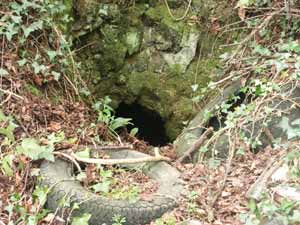Down Lane Adit

By Andrew Westcott
Back To Mining Introduction > Location 3
This page covers the adit at the No.3 location on the map on my 'Mining Introduction' page, the Ordnance Survey coordinates for this site being SX 854 865. Down Lane is what is known as a green lane, meaning it has no sealed surface, and it is now only occasionally used for access to the fields at the top of the hill, although the lane is a right of way for walkers. The workings here are minimal at best, and take the form of a small area of excavation adjacent to and accessible from Down Lane which has been used over the years for dumping scrap iron by the local farmers, but in the context of manganese mining is worth a mention as I honestly doubt anyone else is aware this place exists.
It is, after all, the sort of location only inquisitive children could find.

Photo 1
Odd depression in the fieldA large depression or excavation just inside the gate to this field
When I was in my mid-teens and my interest in old mines was becoming well developed, I decided to examine this area very closely as my parents owned this piece of waste land and the adjacent field. One feature which initially caught my attention was a large depression in the field near its gate which opened out onto the lane, shown in photo 1, and my overactive imagination played with the possibility that this region might just be the evidence of a collapsed underground cavity, and therefore be the result of mining activity. I decided the entrance to this imagined collapsed mine was most likely to be sited within the small quarry mentioned in the previous paragraph, and so I decided to closely examine the excavation as well as I could, despite the decades of scrap metal laying within it.
What I noticed was an area to the Southern side of this small digging that resembled other decayed adit entrances I'd seen, but no adit was visible. I considered the spot interesting enough to enlist the help of an enthusiastic friend, and we set about trying to clear the area. The debris we were removing consisted of a mixture of earth, small stones, bones, rusty iron and a fair number of glass vessels ranging from spice jars to old bottles, most broken but some complete and obviously quite old, which had been dumped in over from the adjacent field.
Unfortunately, I didn't attach any real value to these finds and the odd few interesting bottles I did bring home got lost over the years, although no doubt many more are still buried beneath the rubble awaiting discovery. Of all the interesting finds here, I recall in particular a tin of oxo cubes. The tin was rusty but the label was still intact and readable, and when I managed to open it I saw that it appeared to still be full of the cubes, each one wrapped in its own little cardboard wrapping and clearly marked 'OXO'. Even more interesting was when I took some of these cubes out and found out that the contents had completely disappeared, possibly having been leached out over the years, leaving just a tinful of hollow cardboard cubes. I suppose it is equally possible that someone saw fit to refill the empty Oxo tin with the empty reassembled cardboard cubes, but why anyone would bother I cannot guess. Unfortunately, this find has also become lost over the years.
Although our excavation work was frequently interrupted by these interesting finds, after perhaps an hour or two of digging my spade suddenly went through into a cavity! I could hardly contain my excitement as we scrabbled frantically at the rubble to uncover the entrance and as soon as a hole big enough to enter had been created, I was in there. The entrance we discovered is still there and is shown, in all its glory, in photo 2. As you can see, we only cleared just enough material to allow us to crawl into the hole.
Exciting as the occasion was, the adit we uncovered was in fact rather small, obviously having been driven for exploration and finding nothing of worth. The adit itself, once I'd climbed down over the accumulated rubble which had fallen inwards from the entrance, proved to be a plain tunnel cut into the shale about 4 to 5 feet high and extending for perhaps 20 yards under the neighbouring field directly beneath the depression in the ground at an estimated depth of about 12 feet, dangerously close to the surface although as yet not fallen in, so destroying my theory about the depression in the ground above being caused by an underground collapse. It ends at a rock face displaying shale strata running vertically in the direction of the adit. There is no evidence of mineralisation present although a cavity with a volume of about 1 cubic metre, too small really to be considered a stope, had been dug out to the left of the face for some reason but it is collapsing and the cavity is now gradually working its way towards the surface and will one day result in a hole appearing in the field above it, if it hasn't already done so.
Back to top
I can be contacted at this address:
Copyright © Andrew Westcott 2003 - 2023
I'm happy for anyone to use this material for private, non-commercial or educational purposes, but credit to the author must be given. For any other use please contact me for permission.
